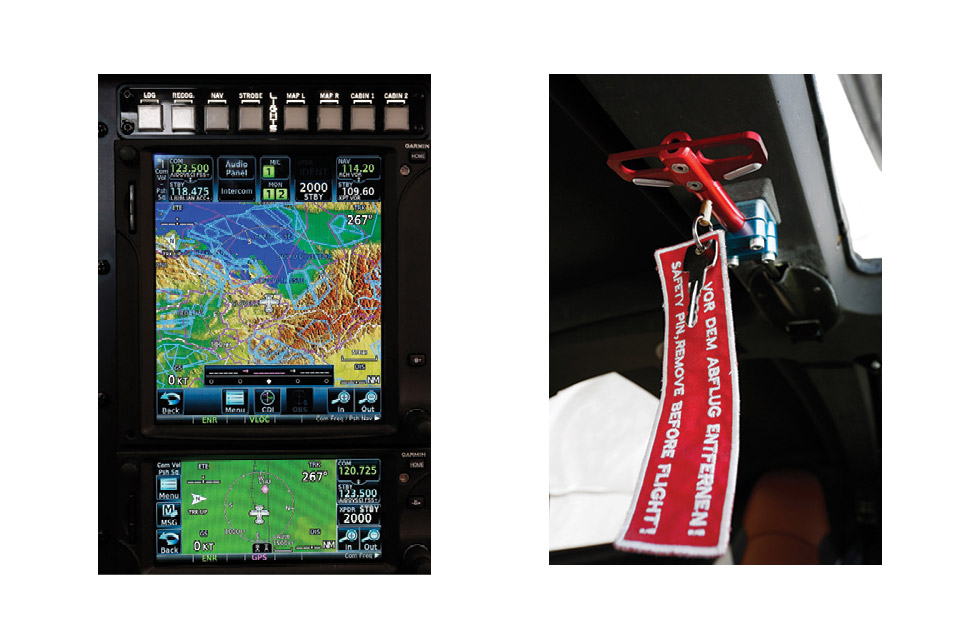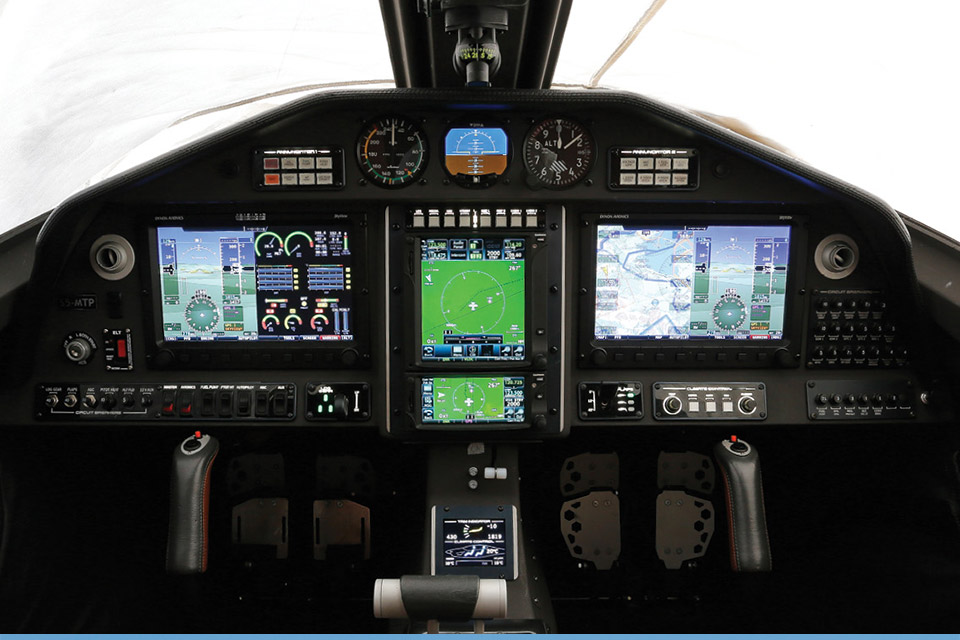Fast cat
Pipistrel designs the airplane of your dreams
Chalk up another innovative new design for Pipistrel. The Slovenian manufacturer, ever at the leading edge of low-drag, high-efficiency, ecologically aware technology, has come up with the Panthera. First revealed at the 2012 AERO Friedrichshafen convention, the Panthera is a super-sleek, carbon-fiber four-seater that will be offered in three variants.
The Experimental prototype Panthera has been making the rounds on demonstration tours, mainly in Europe. It’s powered by a 210-horsepower Lycoming IO-390 engine. During a visit to Pipistrel in spring 2015, I had a chance to fly this first Panthera, the only one then in existence.
The Panthera is an elegant design, with racy, fluid lines; slender wings reminiscent of a sailplane’s; and minimal cooling and interference drag. Its cabin is equally upscale, with gull-wing entry doors, enough interior width for plenty of shoulder room, breathable leather seats, and an overall high-end automotive feel.
What it doesn’t have is initial climb performance. Sure, Pipistrel uses Ajdovscina’s grass-runway airport, but the day I flew the Panthera the conditions weren’t all that bad: The airport elevation is 384 feet, the temperature was hovering around 80 degrees Fahrenheit, and there were two aboard with partial fuel. Pipistrel’s Robert Likar briefed me on the takeoff and other procedures, and any pilot with some complex piston single time would feel right at home with them. Put in one notch of flaps, firewall the throttle, rotate at 63 knots, lift off, raise the gear as you accelerate to 80 knots, retract the flaps at 300 feet agl, and climb away at the VY of 120 knots. I saw a 600-fpm climb, but the trees at the end of the 3,280-foot-long runway seemed to loom pretty large as we passed by. I think a paved runway might have helped dial down the excitement. A lot.
In cruise at 5,000 feet, it was a different story. Here’s where the Panthera absolutely excels. With power set at 25 inches of manifold pressure, prop at 2,500 rpm, mixture leaned to 50 degrees lean of peak exhaust gas temperature, and a fuel burn of just 10 gph, the airplane tooled along at a very respectable 182 KTAS. At this rate, with the Panthera’s 55-gallon-capacity tanks topped off, it could easily cover some 800 nautical miles with reserves in still air.
This should get everyone’s attention. What we’re talking about is an airplane that challenges the performance of the Cessna TTx, Cirrus SR22, and Beechcraft Bonanza A36—using a four-cylinder engine with 90 fewer horsepower, while consuming seven or so fewer gallons per hour—and offering a full-fuel payload of 870 pounds. The unknown factor is price, which Pipistrel has yet to determine for this variant of the Panthera, which may be marketed as an Experimental, amateur-built airplane beginning in 2016.
Slowing down the Panthera in preparation for landing requires a bit of work. You have to really dial back the power to reach the airplane’s 105-knot VFE, and then go to the first notch of flaps and lower the landing gear. I had to add a shot of power to maintain the recommended 90 knots for the entry to base leg, and even more power after going to flaps three (full flaps) to hold 80 knots down final. I was told to hold 80 knots to the threshold, go to idle over the numbers, and flare as usual. Nothing fancy about the touchdown—the trailing-link landing gear made it easy.
It may have been my first-timer’s unfamiliarity with the airplane, but in the tradeoff between low-airspeed handling and cruise performance, it certainly seems as though the designers optimized those wings for efficient cruising. However, slow-deceleration stall behavior was conventional, with no sharp breaks or tendencies to suddenly drop a wing.
The Panthera demonstrator is in high demand, so after my flight Job Snel of iFly—Pipistrel’s dealership for Luxembourg, Belgium, and the Netherlands—took it away for a 10-day promotional tour.
Pipistrel’s famously busy and innovative engineers—the company has won three NASA Green Challenge awards—have come up with no fewer than three future paths for the Panthera airframe.
The one of most interest to the U.S. market is a more powerful Panthera, propelled by a 260-horsepower Lycoming IO-540 engine. It will be certified in 2017 under FAR Part 23, Pipistrel says, and the price is currently set at 460,000 euros (about $493,000 as of mid-November 2015).
Although heavier and thirstier than the IO-390, the -540 will turn in better climb performance, as well as cruise speeds at 55-percent power that will match the IO-390 airplane’s advertised 187-knot high-speed cruise. At 75-percent power settings at 8,000 feet, Pipistrel promises the IO-540 version will cruise at 200 knots.
But wait, there’s more. There’s an electrically powered Panthera on the drawing boards. This model will have a 200-kilowatt electric motor (roughly equivalent to 260 horsepower), with a limitation of 150 kilowatts for maximum continuous power. Pipistrel engineers predict a maximum speed of 175 knots at 15,000 feet, but little else. Range estimates will depend heavily on the battery’s design and power output, obviously, but make no mistake—Pipistrel is an environmentally aware company with a deep commitment to electrical power. Its factory uses geothermal and passive solar technology to cool and heat the building. It has already brought an electrically powered two-seat trainer to market (see “Pipistrel Alpha Electro: The Trainer of the Future?” October 2015 AOPA Pilot). And more developments are on the way.
Such as the final Panthera concept: the hybrid-powered Hypstair. This airplane also will be powered by a 200-kilowatt electric motor that receives its power from two sources: a 200-kilowatt battery, and a generator driven by an unnamed, 135-horsepower “Rotax-like” piston engine. Tine Tomazic, spokesman for Pipistrel’s research and development branch, said the Hypstair will be designed with a “stealth button.”
“You push the stealth button for battery priority for quiet takeoffs in noise-sensitive areas,” he said. “And another button we call the ‘boost button’ unlocks a high-power mode that uses both the battery and the piston engine’s generator to team up and create two times the torque of an IO-540, produce initial climb rates of 1,600 fpm, and cruise as fast as 177 knots at 15,000 feet. And it’s like having a twin. If you lose a motor, you’ll still have 60 percent power.”
But Tomazic emphasized that the real advantage of hybrid power systems isn’t fuel economy, redundant power sources, or noise reduction. It’s that electrical power systems aren’t affected by density altitude—after all, they aren’t affected by varying air densities. So they put out the same thrust at sea level as they do at 10,000 feet. That takes care of the motor output, but propellers are affected by high density altitudes. That’s why the Hypstair will use a specially designed five-blade, low-rpm propeller that’s automatically controlled and alters its speed to compensate for the effects of density altitude, producing the same thrust at different rpm.
You may shake your head, but don’t think this is all pie in the sky. The Hypstair design is frozen, Tomazic said; first flight is set for 2016, and Pipistrel is talking with the European Aviation Safety Agency about certification. No word yet on when that may happen.
Pipistrel is driven. Traditionally, the company has been Euro-centric, with more than half of the 1,300 airplanes it has built over its 28-year history going to European customers. True, there is a North American distribution network, and those involved in the Light Sport aircraft community are certainly aware of the company’s popular Sinus and Virus two-seat, Rotax-powered models. Motorglider enthusiasts know about Pipistrel’s Taurus and Taurus Electro. But for the bulk of mainstream American general aviation pilots, Pipistrel isn’t on the radar.
The Panthera could change all that.
Email [email protected]
SPEC SHEET
Pipistrel Panthera
Base price: 460,000 euros
Specifications
Powerplant | 260-hp Lycoming IO-540-V
Length | 26 ft 6 in
Height | 7 ft 2 in
Wingspan | 35 ft 8 in
Wing area | 121 sq ft
Wing loading | 24 lb/sq ft
Power loading | 11.2 lb/hp
Seats | 4
Max takeoff weight | 2,900 lb
Useful load | 1,100 lb
Payload w/full fuel | 770 lb
Fuel capacity (usable) | 55.4 gal, 332.4 lbs
Performance
Takeoff run | 973 ft
Takeoff distance over 50-ft obstacle | 1,782 ft
Rate of climb, sea level | 1,550 fpm
Cruise speed @ 75% power | 198 KTAS 8,000 ft
@ 65% power, best economy | 193 KTAS 12,000 ft
Service ceiling | 25,000 ft
Landing distance over 50-ft obstacle | 1,881 ft
Limiting and recommended airspeeds
VA (design maneuvering) | 143 KIAS
VFE (max flap extended) | 105 KIAS
VNO (max structural cruising) | 175 KIAS
VNE (never exceed) | 220 KIAS
VS1 (stall, clean) | 65 KIAS
VSO (stall, in landing configuration) |60 KIAS
For more information
Contact Pipistrel USA/Michael Coates, 213-984-1237, [email protected]; www.pipistrel-usa.com; www.panthera-aircraft.com
All specifications are based on manufacturer’s calculations.
Extra
A 260-horsepower, Lycoming IO-540-powered, FAR Part 23-certified Panthera should have a 75-percent power cruise speed of 198 knots at 8,000 feet.












